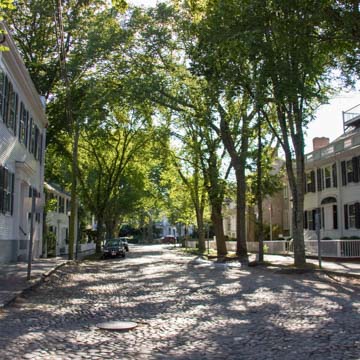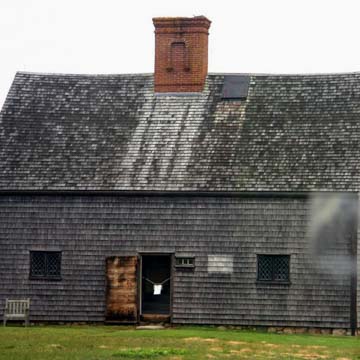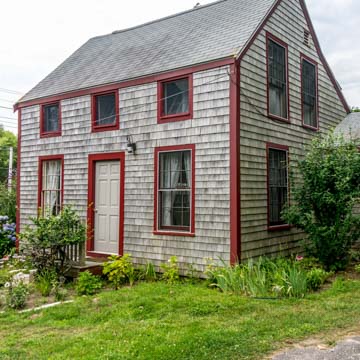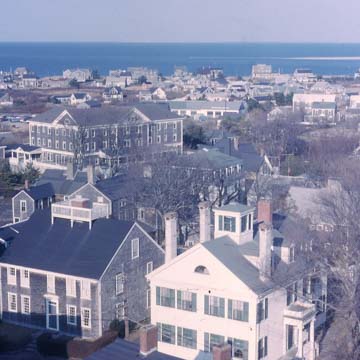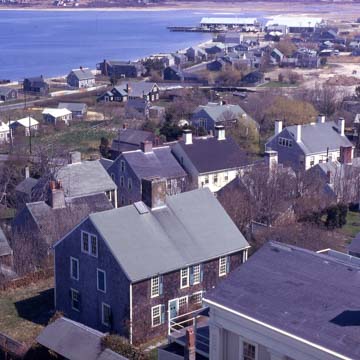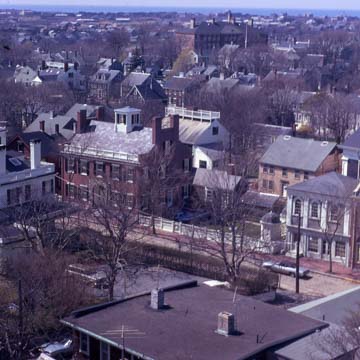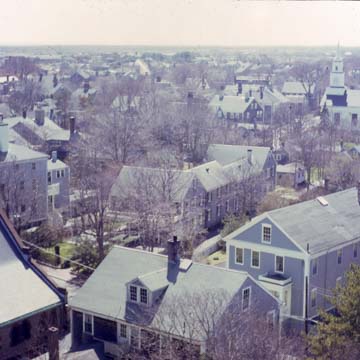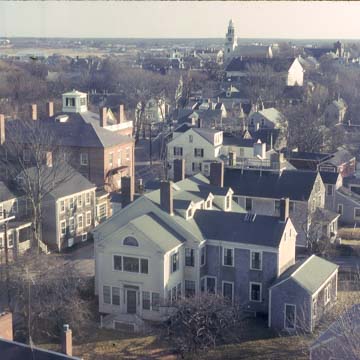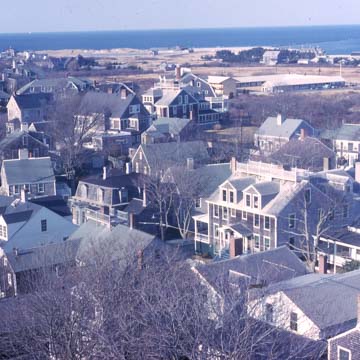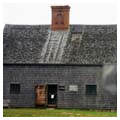Nantucket lives in the popular imagination as a quaint island filled with historic architecture that has evolved into an elite summer enclave. The entire island, some 30,000 acres, constitutes the Nantucket Historic District (a National Historic Landmark District), making it the largest historic district in the United States. The core of the local historic district was first formed in 1955 making it among the oldest in the nation. This initial district encompassed only the town of Nantucket and the village of Siasconset, but it was later expanded to encompass the whole island. While modern preservation efforts certainly contribute to the historic appearance of the island, this alone has not shaped today’s Nantucket. Instead, nineteenth-century efforts to entice tourists and vacationers to an economically stagnant island helped to reinvent Nantucket and create its quintessentially American appearance. It is this nineteenth-century reinvention that the modern historic preservation movement has caused to endure. The Nantucket Historic District showcases simultaneously the deliberate, calculated development of tourism in Massachusetts through the built environment and the modern desire to preserve the perception of an idealized past.
Initially settled by the Wampanoag tribe, Nantucket’s first permanent English colonists, led by the Coffin family, arrived in 1661 seeking to escape Puritan oversight in Massachusetts Bay. The settlement took the name Nantucket (believed to be Wampanoag for “far-away land”) in 1671, though it was subsequently renamed Sherburne and only reverted later to Nantucket. The earliest colonists engaged in subsistence agriculture on farms dispersed across the island, but Nantucket’s iconic open moors proved agriculturally insufficient, reorienting the community toward its large natural harbor and a seafaring economy by the end of the seventeenth century. As early as 1672, Nantucket’s English settlers imitated its Wampanoag inhabitants by operating an inshore whaling fishery and were the first in the colonies to collect and sell whale oil for lighting. They quickly overharvested the fishery and, beginning in the 1690s, an offshore whaling industry grew exponentially, utilizing the island’s position in the Atlantic as a launch point for more distant excursions. That fishery, in turn, collapsed by 1760, and after the American Revolution, Nantucketers shifted to the even more lucrative, but dangerous, long-distance whaling that brought the island its greatest economic development. Nantucket whaling peaked in 1840, as did its population at 9,000. At that point, its natural sandbars precluded the ever-larger ships of the whaling industry from easily docking at the town harbor, forcing many to land at nearby Edgartown on the island of Martha’s Vineyard. Thus, even before the collapse of the national whaling industry due to the development of kerosene as a lighting fuel, Nantucket began a slow economic decline. Its last whaling ship sailed in 1869.
In the midst of the decline of its whaling industry, Nantucket’s central business district, adjacent to the harbor of the town, experienced a devastating fire in 1846 that consumed 36 acres. There was a brief period of rebuilding—mainly two- and three-story brick buildings in the Greek Revival style—but Nantucket’s construction effectively ended in the first half of the nineteenth century as the population continued to decline. By the end of the nineteenth century, the island had only 3,000 residents. As a result of this economic stagnation, existing buildings largely survived intact, resulting in a uniquely preserved landscape.
The declining New England town proved a boon to the economy in the post–Civil War period as a nascent tourist industry began in the region. Nantucket’s leaders capitalized on the nostalgic charm of the island and its apparent “timelessness” (even though many of the buildings then standing were only about fifty years old). Nantucketers tapped into a growing fascination with the country’s colonial past as expressed in the Colonial Revival movement. While they could not claim association with Revolutionary War sites or individuals, they knew that they could offer a quaint landscape that somewhat evoked the values of the colonial and early republican eras. Nantucket boosters looked to transform what had once been a cosmopolitan commercial town into the image of a pristine New England village in the hopes of attracting outside visitors. This required creating the illusion that Nantucket had survived without industry, an idea that further augmented its association with the perceived simplicity and moral superiority of an earlier age. Speculative development in new vacation houses failed, but restoring historic structures proved successful. The goal was producing buildings that did not evoke a particular historical moment, but seemed generally historical and aesthetically pleasing. When possible, islanders promoted those with the oldest building dates, such as the Coffin family rebranding their 1686 farmhouse as the “Oldest House.” From 1870 to 1890, Nantucket’s tourism industry developed rapidly and its reputation as a premier vacation destination grew. On the heels of this, Nantucket also began its first true preservation efforts in 1894, when concerned residents started a campaign to save the “Old Mill,” a 1746 windmill, which was subsequently purchased at auction and donated to the Nantucket Historical Association in 1897.
The extant landscape of Nantucket thus incorporates a small number of scattered seventeenth-century structures associated with its early agricultural period and a larger collection of late-eighteenth- and early-nineteenth-century ones associated with its whaling heyday. The wooden seventeenth-century houses feature strikingly little ornamentation, reflecting their utilitarian nature. The village of Siasconset, on the island’s eastern shore, in particular, retains elements of its seventeenth-century development, including Nantucket’s oldest house, Auld Lang Syne (c. 1676), and the only extant inshore whaling station. In contrast, the often sizeable Federal and Greek Revival residences of the later period, largely in Nantucket town (at the harbor), contain greater embellishment and grander scale, reflecting the high period of the island’s early economy before the decline of whaling. They are complemented by the two- and three-story brick buildings and cobblestone-paved winding ways erected after the 1846 fire.
Nantucket’s nineteenth-century reimagined landscape became one of the earliest to receive dedicated preservation efforts in the twentieth century, which has further contributed to its continued quaint appearance. In 1955, Nantucket became the first town in Massachusetts to utilize enabling legislation to create a local historic district, making it among the first historic districts in the country. Its initial iteration, which included only the historic downtown core and the village of Siasconset, was listed on the National Register of Historic Places in 1966. In 1975, both the local and national districts dramatically expanded to include the entirety of the island as well as the neighboring islands of Tuckernuck and Muskeget.
The district’s governing body, the Nantucket Historic District Commission, has worked assiduously to preserve the island’s character, though Nantucket has undergone modern development in the construction of schools, a hospital, shopping areas, and oil storage tanks, as well as new housing attendant with its burgeoning tourism industry. In addition, the Commission has helped preserve the island’s natural landscapes, including ponds, peat swamps, brush-covered moors, and nearly seventy-five miles of undeveloped coastline, which once hosted numerous whaling stations. The result is a landscape remarkably similar to what existed during its agricultural and whaling past.
In 1990 Nantucket’s population finally surpassed its 1840 peak. Such growth has put increasing pressure on its historic resources. In particular, because building interiors are not subject to the Commission’s jurisdiction, many historic structures are stripped of their interior architectural elements and finishes to make way for modern vacation living. As a result, the National Trust for Historic Preservation placed Nantucket on its 2000 list of America’s 11 Most Endangered Historic Places. Despite such pressures, Nantucket remains a remarkable landscape that showcases the forces that affect preservation: declining economy, reinvention as tourist industry, and legislative preservation efforts.
References
Brown, Dona. Inventing New England: Regional Tourism in the Nineteenth Century. Washington, D.C.: Smithsonian Institution Press, 1995.
Charnes, Georgen, and James Everett Grieder. Nantucket. Charleston, SC: Arcadia Publishing, 2012.
Heintzelman, Patricia, and S. S. Bradford., “Nantucket Historic District,” Nantucket County, Massachusetts. National Register of Historic Places Inventory-Nomination Form, 1975. National Park Service, U.S. Department of the Interior, Washington, D.C.
Lancaster, Clay. The Architecture of Historic Nantucket. New York: McGraw-Hill Book Company, 1972.

